Jio 5G vs Airtel 5G: My experience with 5G network in different Indian cities
When the Indian carriers began rolling out 5G services in India, I was hopeful for and excited about the next revolution in wireless communication in the country. Since October, both Jio and Airtel have aggressively deployed their 5G networks to different parts of India, covering around 180 cities as of today. That is an achievement compared to how 4G networks were rolled out about a decade back. And for someone who was about to experience 5G, I had a lot of expectations. In the anticipation that, for the first time, a mobile network could offer speeds that are practically possible only through a broadband connection, I somehow overlooked the downsides and I did not care.
Over the past few weeks, I used both Airtel and Jio in different cities because I have been travelling. I covered more than 15 cities of North, East, and Northeast India throughout my journey, so naturally, I had access to the 5G network of both carriers in eligible cities. While Jio currently offers its 5G network in more than 180 cities, Airtel is a little behind. The first time I used 5G on my phone, I was in National Capital Region. Sitting on my sofa in my apartment, I surprisingly found my phone showing ‘5G’ for my Airtel number and I immediately gave it a try.
The speeds of the Airtel 5G Plus network in my flat was around 200Mbps — much higher than I have usually experienced on Airtel 4G (70Mbps). The speed fluctuated a lot, but it was not a discerning observation. The latency was adequately low, so for me, using 5G for streaming and playing games. But during that time, Jio’s 5G network was not widely available. Jio was still in the process of officially deploying the 5G network, and even if the network was available, I did not receive the invite to the Welcome Offer. Jio says its unlimited 5G data will be offered to users with Welcome Offer and there is a requirement for eligibility.
Then I moved to Lucknow, where Airtel had rolled out 5G but Jio’s 5G network was unofficially unavailable. Airtel’s speeds remained more or less the same in the Uttar Pradesh capital. I was glad that Airtel’s network did not drop at all and indoor connectivity on 5G was good. After Lucknow, I continued with my journey and reached Siliguri in West Bengal — a city that was among the first ones where Airtel’s 5G network was rolled out. But in Siliguri, Airtel 5G Plus was sporadically available at the time I reached there. But over the next few days, the network improved and I began receiving the 5G network indoors. Here the speeds were not quite as much. Still, the speeds were more than what I was getting there previously on Airtel 4G. Jio, once again, was not available in Siliguri during my stay there.
After Siliguri, I made a halt at Guwahati — Assam’s and Northeast India’s biggest city. Once again, only Airtel 5G Plus was available and Jio had yet to roll out its 5G network there. I found Airtel’s 5G network most stable in Guwahati. Almost never did my phone switch back to 4G, be it indoors or outdoors. And the speed was around 300Mbps, which was fast enough for streaming and playing games. After a few days, I left Guwahati and reached Shillong — Meghalaya’s capital city. Now, neither Airtel nor Jio was officially offering 5G services in Shillong when I reached there, but a few days later, Airtel announced the rollout. The 5G network in Shillong was limited to populous areas initially, so in the place I was staying, the 5G network was almost negligible. But in the areas where Airtel 5G Plus was available, the speeds were terrific. Airtel 5G clocked in more than 600Mbps in Shillong — the best by far. Jio, again, was not available for me to experience.
From Shillong, I reached my hometown, Kanpur — the largest city of Uttar Pradesh and its commercial capital. Both Jio and Airtel had already rolled out their 5G services in Kanpur by the time I reached. Airtel’s 5G network, however, was not widely available here. Instead, Jio had an upper hand in terms of coverage. Airtel’s 5G speeds peaked at 500Mbps in major areas, but even though Jio 5G was available, I could not use it because I was not invited to the Welcome Offer. A couple of days later, I received an invite from Jio and the phone displayed 5G for the Jio network for the first time for me. And this is when I realised how fast Jio was. At one point in time, the speeds of Jio True 5G reached 2.2Gbps, which is phenomenal. But this is not the whole picture.
Although Jio’s 5G speeds were dramatically higher than those of Airtel 5G, the stability was not even half as much. Jio’s network kept doing to and fro between 4G and 5G, and because of that, I experienced issues with basic things such as sending a WhatsApp message. Jio’s 5G network was also very feeble indoors, and this caused me a lot of problems. Since Jio is currently offering unlimited data as a part of the Welcome Offer, I enabled auto-update for mobile apps and set some Netflix shows for download, only to find later that Jio had switched back to the 4G network and because of that my entire data was exhausted. Airtel, on the other hand, was stable even though slightly slower in speed.
It would be unreasonable to discard any of these networks for their 5G rollout yet because both Airtel and Jio are still in the process of deploying 5G. So, their 5G services are understandably not reliable at the moment and there is room for improvement.
The post Jio 5G vs Airtel 5G: My experience with 5G network in different Indian cities appeared first on BGR India.

When the Indian carriers began rolling out 5G services in India, I was hopeful for and excited about the next revolution in wireless communication in the country. Since October, both Jio and Airtel have aggressively deployed their 5G networks to different parts of India, covering around 180 cities as of today. That is an achievement compared to how 4G networks were rolled out about a decade back. And for someone who was about to experience 5G, I had a lot of expectations. In the anticipation that, for the first time, a mobile network could offer speeds that are practically possible only through a broadband connection, I somehow overlooked the downsides and I did not care.
Over the past few weeks, I used both Airtel and Jio in different cities because I have been travelling. I covered more than 15 cities of North, East, and Northeast India throughout my journey, so naturally, I had access to the 5G network of both carriers in eligible cities. While Jio currently offers its 5G network in more than 180 cities, Airtel is a little behind. The first time I used 5G on my phone, I was in National Capital Region. Sitting on my sofa in my apartment, I surprisingly found my phone showing ‘5G’ for my Airtel number and I immediately gave it a try.
The speeds of the Airtel 5G Plus network in my flat was around 200Mbps — much higher than I have usually experienced on Airtel 4G (70Mbps). The speed fluctuated a lot, but it was not a discerning observation. The latency was adequately low, so for me, using 5G for streaming and playing games. But during that time, Jio’s 5G network was not widely available. Jio was still in the process of officially deploying the 5G network, and even if the network was available, I did not receive the invite to the Welcome Offer. Jio says its unlimited 5G data will be offered to users with Welcome Offer and there is a requirement for eligibility.
Then I moved to Lucknow, where Airtel had rolled out 5G but Jio’s 5G network was unofficially unavailable. Airtel’s speeds remained more or less the same in the Uttar Pradesh capital. I was glad that Airtel’s network did not drop at all and indoor connectivity on 5G was good. After Lucknow, I continued with my journey and reached Siliguri in West Bengal — a city that was among the first ones where Airtel’s 5G network was rolled out. But in Siliguri, Airtel 5G Plus was sporadically available at the time I reached there. But over the next few days, the network improved and I began receiving the 5G network indoors. Here the speeds were not quite as much. Still, the speeds were more than what I was getting there previously on Airtel 4G. Jio, once again, was not available in Siliguri during my stay there.
After Siliguri, I made a halt at Guwahati — Assam’s and Northeast India’s biggest city. Once again, only Airtel 5G Plus was available and Jio had yet to roll out its 5G network there. I found Airtel’s 5G network most stable in Guwahati. Almost never did my phone switch back to 4G, be it indoors or outdoors. And the speed was around 300Mbps, which was fast enough for streaming and playing games. After a few days, I left Guwahati and reached Shillong — Meghalaya’s capital city. Now, neither Airtel nor Jio was officially offering 5G services in Shillong when I reached there, but a few days later, Airtel announced the rollout. The 5G network in Shillong was limited to populous areas initially, so in the place I was staying, the 5G network was almost negligible. But in the areas where Airtel 5G Plus was available, the speeds were terrific. Airtel 5G clocked in more than 600Mbps in Shillong — the best by far. Jio, again, was not available for me to experience.
From Shillong, I reached my hometown, Kanpur — the largest city of Uttar Pradesh and its commercial capital. Both Jio and Airtel had already rolled out their 5G services in Kanpur by the time I reached. Airtel’s 5G network, however, was not widely available here. Instead, Jio had an upper hand in terms of coverage. Airtel’s 5G speeds peaked at 500Mbps in major areas, but even though Jio 5G was available, I could not use it because I was not invited to the Welcome Offer. A couple of days later, I received an invite from Jio and the phone displayed 5G for the Jio network for the first time for me. And this is when I realised how fast Jio was. At one point in time, the speeds of Jio True 5G reached 2.2Gbps, which is phenomenal. But this is not the whole picture.
Although Jio’s 5G speeds were dramatically higher than those of Airtel 5G, the stability was not even half as much. Jio’s network kept doing to and fro between 4G and 5G, and because of that, I experienced issues with basic things such as sending a WhatsApp message. Jio’s 5G network was also very feeble indoors, and this caused me a lot of problems. Since Jio is currently offering unlimited data as a part of the Welcome Offer, I enabled auto-update for mobile apps and set some Netflix shows for download, only to find later that Jio had switched back to the 4G network and because of that my entire data was exhausted. Airtel, on the other hand, was stable even though slightly slower in speed.
It would be unreasonable to discard any of these networks for their 5G rollout yet because both Airtel and Jio are still in the process of deploying 5G. So, their 5G services are understandably not reliable at the moment and there is room for improvement.
The post Jio 5G vs Airtel 5G: My experience with 5G network in different Indian cities appeared first on BGR India.







